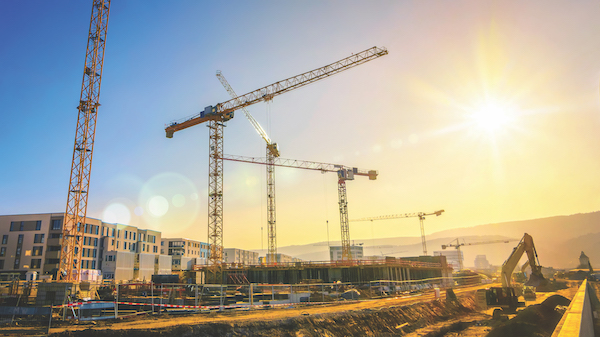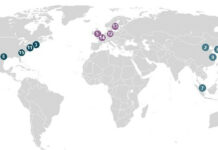By Johan Beukema and Maurice Kuipers
From the May / June 2023 Issue
Geopolitical tensions, war in Ukraine, high inflation, labor market pressures, natural disasters, and other unexpected disruptions are driving companies to plan for a future in which uncertainty has become the new normal. The Volatile, Uncertain, Complex, and Ambiguous (VUCA) world that we live in must be taken into account in companies’ overall business strategy development and therefore also in the resulting manufacturing footprint and location strategies.
In this article we give our insight, based on our own global practice in working with companies in optimizing their manufacturing footprints and selecting new locations, in how this results in different decisions than before.

External Factors Driving Change
External factors that drive change in manufacturing footprints are numerous. Four prominent reasons for companies to adapt their footprint are changing regional risk profiles, increasing regional cost profiles, access to resources, and more stringent corporate social responsibility requirements.
Regional risk profiles. Geopolitical tensions with disruptive consequences for manufacturing footprints are currently clearly displayed by the Russia-Ukraine war. Supply chains to and from Russia are impacted because of heavy international sanctions. Ukraine is a war zone allowing almost no trade flows. A second geopolitical conflict, maybe with even more economic impact in the long term, is the U.S. – China trade war. In first instance the main goal for the U.S. was to reduce the bilateral trade deficit. This was followed soon by restricting high tech exports to China to keep the upper hand as the leading tech nation. U.S. allies and trade partners got involved as well. A recent example is the restriction for Dutch chip making equipment company ASML in exporting its most advanced machines to China. Meanwhile, changing environmental risks come as a result of global warming. Some regions experience more regular floodings and extreme weather conditions.
Regional cost profiles. In mature Western economies, but even more so in upcoming regions, costs have increased sharply. Take for example the Central and Eastern European countries Poland and the Czech Republic with year-on-year labor cost increases at around 10%. Or Mexico with an annual labor cost increase of up to 20% in manufacturing jobs. In China the average labor cost increases at a slower rate (around 5%), but strong economic regions like Shanghai are now for certain types of job profiles already on par, or even more expensive than many Western European and U.S. regions.
Access to resources. All over the world our partners and clients report that labor markets are tight, raw materials scarce, and access to energy not always guaranteed. China for example is struggling with an aging population, but also worker preferences are changing: the new middle class wants to work in an office, not in a factory.
As a result of the COVID-19 lockdowns supply chains were disrupted, and many raw materials and semi-finished products became scarce and (very) expensive. The markets are recovering from that, but now the main concern is about who controls the raw material sources. In the battery industry for example Europe is dependent on mainly China, India, and African countries. Especially hard felt in Europe are rising energy costs because of limited supply now that Russia is no longer is a major supplier of natural gas. New sources need to be found until the energy transition has progressed significantly. An example is the liquefied natural gas (LNG) imported from the U.S. and the Middle East.
Corporate social responsibility. The fourth fast changing external change factor we bring forward is corporate social responsibility. Bound by the Paris Agreement, countries aim to reduce carbon emissions significantly. The EU for example has already pledged to reduce CO2 emissions by 55% until 2030 (compared to 1990). In another field, the EU is a front runner. On January 5, 2023, the Corporate Sustainability Reporting Directive (CSRD) became effective. This new directive strengthens the rules concerning the social and environmental information that companies have to report. The first companies will have to apply the new rules in the 2024 financial year, for reports published in 2025.

Drivers & Strategies: The Changing Environment
We see companies developing and implementing different footprint strategies in order to prepare themselves for dealing with continued uncertainty in the future. Below we look into three potential strategies in more detail:
- Strategy 1: Decentralization of the manufacturing footprint
- Strategy 2: Friend-shoring
- Strategy 3: Decarbonization of the footprint
The decentralization strategy focuses on regionalization, dual sourcing, and/or reshoring. The main goal is the same: reduce risk by putting your eggs in multiple baskets. Having more plants with similar competencies provides companies backup capacity. Reshoring means less exposure to geopolitical tensions, and dual sourcing increases raw material independence.
Friend-shoring is mainly applied by companies that have operations in China (and nowadays Russia). In the period after the Cold War came to an end (and before the current trade war started), location strategies were aimed at finding the best fitting business environment. There were (almost) no regions where geopolitical circumstances were so hostile that landing a new operation was not an option. Nowadays, Western companies face more hostile circumstances in several geographies. Given all developments that are ongoing at a global geopolitical level, decoupling of value chains from China is gearing up. This will encourage companies to consider alternative locations for new investments, after US tech companies like Apple, Amazon and Google already moved significant operations from China to e.g. Vietnam and India. (Editor’s Note: See The Last Word from this issue for more on this topic.)
A strategy to cope with the CO2 emission reduction requirements is to decarbonize the manufacturing footprint. We have not yet seen companies that indicate CO2 reduction as the principal driver for changing a manufacturing footprint. But in more and more projects for clients, assessing the carbon footprint is an integral part of the wider analysis that leads to an alternative manufacturing footprint. In the years ahead, this may become the norm.
Manufacturing Footprint Strategies
The table below looks at how different manufacturing footprint strategies are used to address external factors. In our daily practice, companies indicate the regional risk profile, regional cost profile, and access to resources are strong drivers for adjusting location strategy. Although corporate social responsibility (CSR) is not (yet) seen as a strong enough driver in its own, it does play a role in final decision-making. The table below highlights these four fast changing external factors and indicates which strategy may be used to address them.
Impact On Location Decisions
In adapting to a fast-changing world, companies choose different manufacturing footprint strategies. Whatever solution is chosen, selecting the right location is key: In which regional labor markets do you find the talent you need? Where do you find sufficient supply of energy, and should it be renewable energy? Which countries offer a stable and welcoming environment?
To conclude: In supporting companies to develop their worldwide manufacturing footprint and location strategies, BCI Global has identified five factors that have gained importance.
- Talent: Finding talent is a key driver in making location decisions. It is no longer about finding skilled labor at the lowest cost; it has moved towards finding the right talent base and accepting the cost.
- Ecosystem: Especially for companies with complex supply chains, a region should offer a strong ecosystem in terms of suppliers, education, research, peer companies, etc. Now that the pressure for adjusting a supply chain has increased, selecting a strong ecosystem that addresses a company’s needs and is future-proof is the challenge.
- Cost projections: In selecting a new location, a focus on the current cost level is no longer sufficient. In-depth analysis of the projected development of regional cost levels can make or break the business case.
- Risk: The changing geopolitical situation comes with higher risk in specific regions. We see some of our clients have moved away from high risk locations.
- Sustainability: Not only governmental regulations require companies to comply with new standards. In many cases, customers actively demand a company operate sustainably. Selecting locations close to market, close to suppliers or able to offer sustainable transport solutions has become more important.
Beukema is Managing Partner of BCI Global, leading the firm’s global practice in manufacturing footprint strategy and location and site selection. In his 23+ year career he has sup-ported companies in optimizing their value chains in EMEA, The Americas, and Asia-Pacific. Beukema’s experience includes a variety of manufacturing industries such as bio-pharmaceuticals, medtech, food, chemicals, industrial tools and equipment, and automotive.
Kuipers is an experienced senior consultant at BCI Global. In his 20+ year career he has executed and managed projects for leading companies in optimizing their manufacturing footprints and in find the right location for new manufacturing sites, distribution centers, or back office operations. Kuipers has on the ground experience across the globe, and in addition to corporate clients he works for national and regional economic development agencies in inward investment strategy development, value proposition development, and more.
Check out all the latest news related to the supply chain and economic development, corporate relocation, corporate expansion and site selection.
Case Study:
Import Cargo At U.S. Ports On The Rise
Import cargo volume at U.S. major container ports is climbing back from a nearly three-year low in February, but is expected to remain below last year’s levels heading into this fall, according to the Global Port Tracker report released by the National Retail Federation (NRF) and Hackett Associates.
“Consumers are still spending and retail sales are expected to increase this year, but we’re not seeing the explosive demand we saw the past two years,” NRF Vice President for Supply Chain and Customs Policy Jonathan Gold said. “Congestion at the ports has largely gone away as import levels have fallen, but other supply chain challenges remain, ranging from trucker shortages to getting empty containers back to terminals. We were pleased by recent reports of progress related to the West Coast port labor negotiations but will continue to monitor the situation closely until there is a new agreement ratified by both parties.”

U.S. ports covered by Global Port Tracker handled 1.62 million Twenty-Foot Equivalent Units (TEUs) in March, the latest month for which final numbers were available. That was up 5% from February—which saw the lowest levels since May 2020—but down 30.6% year over year.
The Global Port Tracker forecast for May 2023 is 1.83 million TEU, down 23.5% from last year’s 2.4 million TEU (the all-time record for the number of containers imported during a single month). The first half of 2023—previously forecast at 10.8 million TEU—is now forecast at 10.4 million TEU, down 22.8% from the first half of 2022. Imports for all of 2022 totaled 25.5 million TEU, down 1.2% from the annual record of 25.8 million TEU set in 2021.
Global Port Tracker is produced for NRF by Hackett Associates and provides historical data and forecasts for the U.S. ports of Los Angeles/Long Beach, Oakland, Seattle and Tacoma on the West Coast; New York/New Jersey, Port of Virginia, Charleston, Savannah, Port Everglades, Miami and Jacksonville on the East Coast, and Houston on the Gulf Coast. ♦

















![[VIDEO] Get More for Your Business in Ardmore. Oklahoma](https://businessfacilities.com/wp-content/uploads/2024/02/maxresdefault-324x160.jpg)
